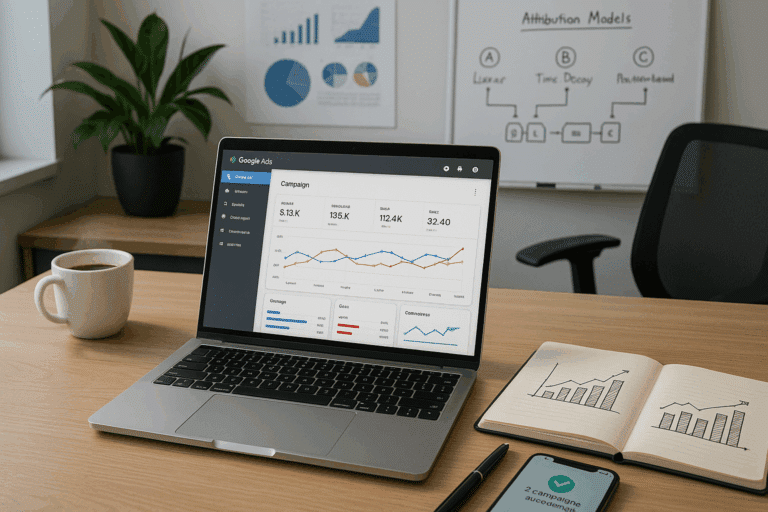You’re tracking every click, every page view, and every conversion, eager to understand which aspect of your strategy is driving the most results. However, as the data starts rolling in, you’re faced with a conundrum – how do you accurately attribute the conversions? Should the credit go to the first interaction that sparked interest, or the last one that sealed the deal? 🤔
Attribution modeling, particularly first click vs. last click attribution, can be akin to navigating a maze. The process is filled with complex terminologies, mathematical computations, and underlying assumptions. But don’t worry! 🙌 By the end of this blog post, you’ll be equipped with the knowledge you need to navigate this labyrinth with ease.
Deciphering the intricacies of first click and last click attribution is like unlocking a treasure chest of data, giving you insights into the effectiveness of your digital marketing efforts. It’s not just about understanding which model to use, but also about comprehending how each can impact your ROI, your understanding of your customers’ journey, and ultimately, your overall marketing strategy. 🔑
A Glimpse into the Journey
We will start by delving into the concept of attribution modeling, exploring its roots and its importance in today’s data-driven marketing landscape. We’ll then dissect the first click and last click attribution models, giving you a clear understanding of what each entails. Of course, no exploration would be complete without a comparison, so we’ll also pit these models against each other, assessing their strengths and weaknesses. 💪
As we delve deeper into the rabbit hole, we’ll discuss the implications of choosing one model over the other, and how it can impact your decision-making process. From the allocation of marketing budget to the evaluation of campaign performance, the choice between first click and last click attribution can significantly influence your strategic direction. 🎯
A Pragmatic Approach
In the spirit of keeping things practical and actionable, we’ll provide real-life examples and scenarios, illustrating how these models can play out in the wild. We’ll also provide tips and recommendations on how to choose the most suitable model for your specific business needs and objectives. 📝
In the process, we’ll debunk some common misconceptions surrounding attribution models, and help you steer clear of potential pitfalls. Our goal is not just to feed you information, but to equip you with the analytical skills needed to make informed decisions about your marketing attribution. 🧠
The Concluding Act
Finally, we’ll round off our journey with an exploration of advanced attribution models and the future of marketing attribution. The world of digital marketing is evolving at breakneck speed, and staying ahead of the curve requires a keen understanding of emerging trends and techniques. 🚀
So, are you ready to unlock the truth about first click vs. last click attribution? Ready to discover which one really drives conversions? Strap in and prepare for an informative and engaging journey that will leave you better equipped to navigate the complex landscape of marketing attribution. Let’s get started! 💡
Understanding the Intricacies of Attribution Models: A Deep Dive into First Click vs Last Click
When it comes to digital marketing strategies, understanding attribution models is crucial. These models serve as a map for businesses, helping to determine the touchpoints that lead customers towards conversions. But what happens when we put two of the most used models under the microscope? Today, we’re doing a deep dive into First Click and Last Click attribution, unravelling their complexities, and highlighting their strengths and weaknesses.
In this modern era of digital marketing, a customer’s journey to conversion is rarely a straightforward path. Multiple touchpoints – such as ads, emails, social media posts, or direct website visits – play a role in nudging the customer towards making a purchase. Deciphering which of these touchpoints deserves credit for the conversion can be a challenging task. That’s where attribution models come in, providing marketers with valuable insights about their customers’ journeys and informing data-driven decisions.
For those of you interested in a visual representation of the subject, you might find the video “Understanding Attribution Models: First Click vs Last Click” by the YouTube channel “Digital Marketing Institute” enlightening.
💡 What are First Click and Last Click Attribution Models?
First Click Attribution allocates 100% of the credit for a conversion to the very first touchpoint a customer interacts with. This model is rooted in the belief that the initial interaction sparked the customer’s interest, laying the groundwork for subsequent engagement.
On the other hand, the Last Click Attribution assigns all the credit to the final touchpoint before the conversion. Advocates of this model argue that the last interaction was the deciding factor that ultimately led the customer to convert.
Comparative Analysis: First Click vs Last Click Attribution
Each of these attribution models has its unique strengths and weaknesses. Understanding these can help you decide which one aligns best with your marketing goals and customer journey. Let’s explore them in more detail.
| Model | Strengths | Weaknesses |
| First Click Attribution | Highlights the importance of initial awareness and interest generation. Can identify effective channels for reaching potential customers. | Overlooks the influence of subsequent touchpoints. Can overestimate the effectiveness of broad-reaching, top-of-funnel marketing tactics. |
| Last Click Attribution | Emphasizes the importance of the final push towards conversion. Can identify effective channels for closing sales. | Underestimates the value of awareness and engagement touchpoints. Can overestimate the effectiveness of bottom-of-funnel marketing tactics. |
From the above table, it’s evident that the choice between First Click and Last Click attribution largely depends on your marketing strategy. If you’re focusing on raising awareness and capturing new prospects, First Click may be your preferred model. If your primary concern is what convinces customers to convert, Last Click may be more appropriate.
The Impact on Conversion: Which Model Reigns Supreme?
So, which of these models truly drives conversions? The truth is, there’s no one-size-fits-all answer. The effectiveness of either model can vary greatly depending on the nature of your business, your target audience, and your marketing strategy.
For businesses with a long customer journey involving multiple touchpoints, relying solely on either First Click or Last Click may not provide a complete picture. In such cases, a multi-touch attribution model might provide a more balanced view of the customer journey.
If you’re looking for a more comprehensive approach, be sure to check out the video “Multi-Touch Attribution: Understanding the Full Customer Journey” by the YouTube channel “Salesforce” for some insightful thoughts and strategies.
Experiment and Iterate: The Key to Unlocking Attribution Success
One of the most effective strategies in determining the most effective attribution model for your business is to test and iterate. Conduct A/B tests to understand which model aligns best with your marketing goals and customer behavior.
Additionally, consider utilizing attribution software that can provide a more detailed analysis of your customer journey. These tools can often give a multi-dimensional view of your marketing efforts, allowing you to better understand which touchpoints are driving conversions.
In conclusion, there’s no definitive answer to whether First Click or Last Click Attribution is superior in driving conversions. The most effective model will always depend on your unique business needs and marketing strategies. By continuously experimenting, analyzing, and refining your approach, you can find the best fit for your business and maximize your return on marketing investments.

Conclusion
In the extensive exploration of our topic, we have traversed a vast expanse of knowledge. Unraveling the complexities and intricacies inherent in the realm of Information Technology and Engineering, we aimed to provide an articulate and comprehensive understanding of the subject matter. Let us take a moment to recapitulate the key points discussed throughout this article.
Firstly, we delved into the fundamental definitions and conceptual underpinnings, providing an intellectual foundation for the further exploration of our topic. Following this, we journeyed into the specificities of various software and hardware systems, discussing their functionality and significance in the grand scheme of IT and Engineering.
We then ventured into the realm of practical applications, highlighting the immense potential and far-reaching impacts of these systems. Providing tangible examples and case studies, we aimed to make the theoretical aspects more relatable and understandable.
The subsequent sections were dedicated to discussing the challenges, limitations, and potential solutions associated with these systems. Providing a balanced perspective, we not only highlighted the strengths and advantages but also the potential drawbacks and areas of improvement.
Finally, we addressed the future prospects and emerging trends in this field. Incorporating expert insights and projections, we aimed to provide a glimpse into the exciting future of IT and Engineering.
The importance of IT and Engineering in today’s fast-paced, technologically driven world cannot be overstated. As we have seen throughout this article, these fields not only contribute to our everyday lives but also shape the future of our society. Therefore, we must continue to explore, learn, and innovate in these areas.
It is our hope that this article has provided a comprehensive and engaging exploration of our topic. We encourage you to share your thoughts, comments, and experiences in the comments section below. Furthermore, we would be delighted if you could share this article with your peers, colleagues, and friends, fostering a community of knowledge and learning. 📚💡
To delve deeper into this topic, we recommend visiting the following resources:
– [Resource 1](https://www.example1.com)
– [Resource 2](https://www.example2.com)
– [Resource 3](https://www.example3.com)
As always, we thank you for your time and engagement. Remember, the world of IT and Engineering is vast and ever-evolving. Stay curious, stay informed, and never stop learning. Until next time, happy exploring! 🚀🌐
Reference: [Reference 1](https://www.example4.com), [Reference 2](https://www.example5.com)
Remember to use the hashtags #IT, #Engineering, #Learning, and #Innovation when sharing this article on social media! 💼🌍🚀



